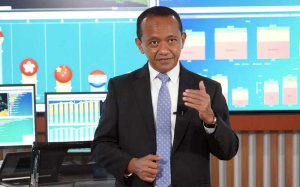Indonesia to boost agricultural industrialization, focusing on seaweed development
The government of President-elect Prabowo Subianto is set to enhance its industrialization strategy by focusing on agricultural commodities, particularly seaweed, a Cabinet minister says.
Minister of Investment/Head of the Investment Coordinating Board (BKPM) Rosan P. Roeslani announced that the government has developed a strategic roadmap for industrialization, shifting beyond the mining sector to maximize the potential of several key agricultural products, including seaweed, crude palm oil, nutmeg, rubber, coconut, and blue swimming crab.
"The next commodity that will be prioritized in our industrialization program is seaweed," Rosan told a media conference on Tuesday, October 15, 2024.
He elaborated that seaweed has vast downstream applications, such as in food products, cosmetics, and agar-agar production. Indonesia’s extensive coastline, spanning 99,093 kilometers, offers a significant comparative advantage for seaweed cultivation.
The Coordinating Ministry of Maritime Affairs and Investment estimates that the added value from seaweed industrialization could reach US$11.8 billion (Rp182 trillion).
To kickstart this initiative, the government plans to launch a pilot seaweed farming project worth US$2 million (Rp31.06 billion) next year.
Rosan noted that since 2020, the total investment in Indonesia's industrialization initiatives has amounted to US$78.7 billion (Rp1,245.8 trillion), with 61 percent of the funds allocated to smelters, equating to US$48 billion (Rp759. 83 trillion).
The forestry sector, primarily paper and pulp industries, has received an investment of US$12.6 billion (Rp196.99 trillion), while the agricultural sector, particularly crude palm oil and oleochemical industries, has attracted US$8.3 billion (Rp130.33 trillion).
Seaweed is expected to become a major economic driver, with projections showing peak demand for seaweed-derived products in 2040.
By that time, the global market for organic fertilizers made from seaweed could reach US$10 billion, while eco-friendly plastics could grow beyond US$40 billion.
Domestically, seaweed prices range between US$1,000 and US$ 2,000 per ton, depending on the grade and usage. Higher-end applications, such as organic fertilizer and pharmaceutical production, could push prices up to US$13,000 per ton.
Seaweed is also seen as a cost-effective alternative in the industrialization sector.
For instance, developing 1.2 million hectares of seaweed farms would require an investment of just US$48 million, far less than the capital-intensive nickel sector.
Indonesia's commitment to enhancing its agricultural industrialization marks a significant step toward diversifying the economy and creating sustainable, long-term growth.
By leveraging the country’s vast natural resources, particularly seaweed, the government aims to create jobs and boost its position in the global market for sustainable products.
Tag
Already have an account? Sign In
-
Start reading
Freemium
-
Monthly Subscription
20% OFF$29.75
$37.19/MonthCancel anytime
This offer is open to all new subscribers!
Subscribe now -
Yearly Subscription
33% OFF$228.13
$340.5/YearCancel anytime
This offer is open to all new subscribers!
Subscribe now





